"Debjani don't you think we need to re-introduce Pithe Payesh to Pasta" Mehebub asked a few days back! Though he was not much happy with my reply "you mean you are craving for the Pithe Payesh, ain't it 😛 ! Pasta is well aware of the taste of Pithe Puli dear husband!" However, Mehebub is clever and finally admitted that indeed he was! On that note, I made this year's first batch of Pithe yesterday. This year I started with the simple yet blissful Choshir Payesh or Choshi Pithe.
Jump to:
Makar Sankranti and Pithe Puli
Now that tomorrow is Makar Sankranti, I plan to make a few more delicacies to celebrate the festival of harvest which includes Patishapta, Saruchakli, Dudhpuli, Bhaja Pithe and Gokul Pithe. Okay, these are actually in the planning phase, and I am not sure how much I will be able to make upon returning home today from office. Needless to say, whatever I will prepare will be there on Debjanir Rannaghar along with the recipes shortly.
About Choshir Payesh
Choshi is a tiny Elliptical shaped Pithe either prepared with a paste of Rice flour or all-purpose Flour. The choshi pithe is then cooked with milk and jaggery and turned into Choshir Payesh. This Kheer is a famous Bengali Winter delicacy prepared during Makar Sankranti. Look-wise it is similar to long grain rice and we cook it with milk to prepare the Payesh. Dida (my maternal grandmother) used to make the Choshir Payesh a lot. One thing Dida used to be very particular that to use Gobindobhog or any flavored rice while making the Choshi. It actually is the rice and jaggery that gives the Chooshir Payesh a distinct flavor given no flavoring agent, in general, is not added while making the payesh.
Making Choshi at home

Choshi though is different than other forms of Pithe or Puli. Shape-wise similar to a typical Pithe but almost pint-sized and with no filling and then cooked with Milk and Date palm jaggery. These days you can find make it packets of Choshi premix (only the dumpling) very easily in the local market and in the Bengali specialty stores in other states or outside the country. those are actually handy however, I prefer to make the Choshi at home whenever I cook Choshir Payesh.
About the recipe
Coming to the recipe, I opt for a mixture of Gobindobhog Rice Powder and Semolina to make the Choshi. I use Patali Gur or Date Palm Jaggery as the sweetener and obviously, full-cream milk is another important ingredient for Choshir Payesh.
Print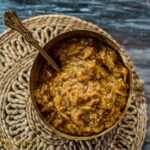
Choshir Payesh
- Total Time: 1 hour 30 mins
- Yield: 6 People 1x
- Diet: Vegetarian
Description
Choshi is a tiny Elliptical shaped Pithe either prepared with a paste of Rice flour or all-purpose Flour. The Choshi is cooked with milk and jaggery and turned into Choshir Payesh. This is a signature Bengali dessert cooked during Makar Sankranti.
Ingredients
To make Choshi:
- 100g Gobindobhog Rice
- 1 Tbsp. Semolina
- 1 pinch Salt: 1 pinch (optional)
- 1 cup Hot Water
To Make Choshir Payesh:
- 1 cup Choshi
- 2 liters Full-Cream Milk
- 300g Date Palm Jaggery aka Patali Gur
- 1 Tsp. Ghee
- 1 Bay Leaf (optional)
Instructions
To make Choshi:
- Wash Rice 2-3 times under running water and sundry the rice completely. This will take around two days to completely sundry the rice.
- Now make a fine powder of the rice. You can make the Rice Powder in bulk and use it as and when required.
- Take 100g Rice Powder and Semolina in a bowl along with a pinch of salt and mix thoroughly.
- Now add 2-3 Tbsp. hot water and start kneading.
- Add water little by little to make a tight dough.
- Once the dough is prepared cover it with a wet cloth and give rest for 15 minutes.
- Now take a pinch size dough and using your finger give it an elliptical shape. It should look like a rice grain both in size and shape.
- Following the same process make the rest of the "Choshi".
- The size of Choshi varies from person to person, however, I prefer the rice grain size.
- Once prepared sundry the Choshi completely. You can store excess Choshi in an airtight container.
To make Choshir Payesh:
- Take the milk in a deep bottom pan and start boiling it after adding 2 cups of water and 1 bay leaf till the milk reduces to ⅔.
- Add Ghee in between.
- Once the milk reduces to ⅔, add 1 Cup of Choshi to the milk and keep cooking on low flame.
- Cook until the milk thickens and Choshi turned translucent in color.
- Add Date Palm Jaggery and mix thoroughly and cook for 5 minutes and then switch the flame off.
- Serve Choshir Payesh at room temperature. I, however, prefer to serve it after storing it for one day in the refrigerator.
Notes
- You can purchase Choshi directly from the market instead of preparing at home.
- While making the Choshi at home, you can use readily available rice flour instead of making it at home.
- Some people prefer to fry the choshi before adding it to the milk, however, I don't do that. Given when the choshi added directly to the milk rice residue extracted from it helps to thicken the milk quickly and also gives extra flavor.
- I don't add any dry fruits in Choshir Payesh. You can obviously add your choice of dry fruits to make it richer.
- You can substitute Date Palm Jaggery completely with Sugar or use both. however, the jaggery gives an amazing flavor to the Choshir Payesh.
- Prep Time: 30 mins
- Cook Time: 1 hour
- Category: Dessert
- Method: Cooking
- Cuisine: Bengali
Nutrition
- Serving Size: 200ml
- Calories: 1110
- Sugar: 75g
- Fat: 42.1g
- Saturated Fat: 25.5g
- Carbohydrates: 150.4g
- Fiber: 0.4g
- Protein: 38.4g
- Cholesterol: 159mg
Winter delicacies from Debjanir Rannaghar
- Komola Kheer | Kheer Komola | Bengali Orange Kheer | Komlalebur Payesh
- Khejur Gurer Payesh | Bengali Rice Kheer with Date Palm Jaggery
- Gur diye Topa Kul ar Tomato Chutney; it is all about chetey chetey Khawa.....
- Nolen Gurer Sandesh
- Phulkopi Aloo diye Chingri Kaliya (also known as Bengali Prawn Curry with Potato and Cauliflower)
- Phulkopir Singara | Kolkata style Fulkopir Shingara Recipe
- Koraishutir Kochuri (also known as Bengali Peas Kachauri)
- Natun Aloor Dum | Bengali Niramish Aloor Dum | Dum Aloo Recipe
- Gokul Pithe (also known as Bengali Madan Gokul Pitha)
- Narkeli Jam Pitha
- Dudh Puli
- Patishapta (also known as Bengali Patishapta Pitha)
Have you tried the Chooshi Payesh recipe from Debjanir Rannaghar!
I would love to see a picture if you are making it following my recipe. You can share here on dolonchttrj@gmail.com. You can use my hashtag #debjanirrannaghar and share it through Instagram as well. and in addition, you can tag me at @foodofdebjani.
Here's the Choshir Payesh Recipe Pin for your Pinterest Board!
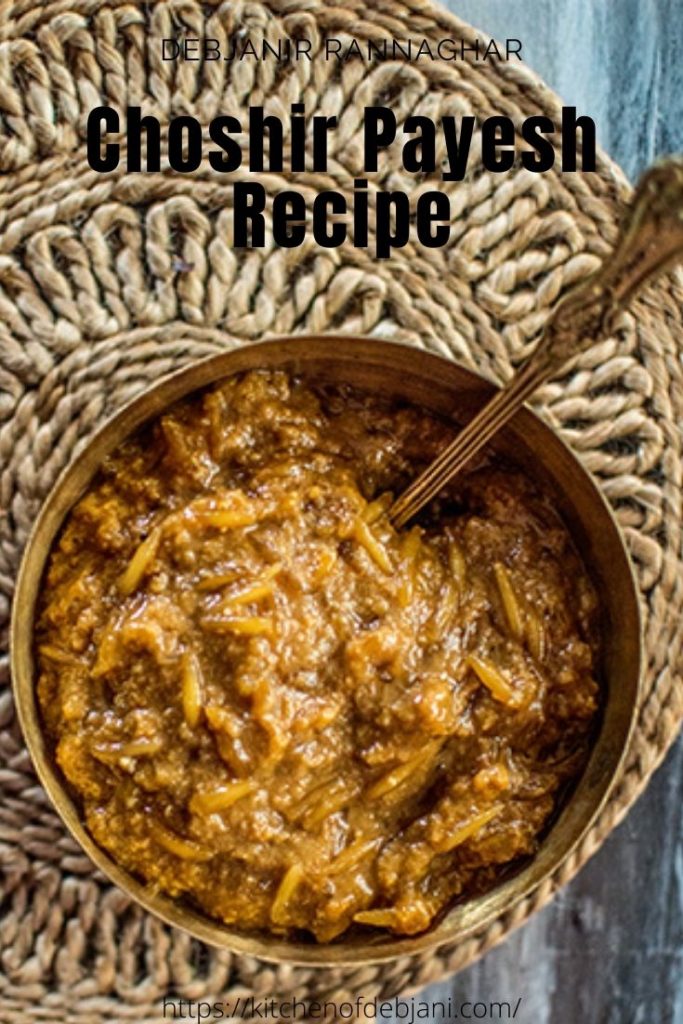

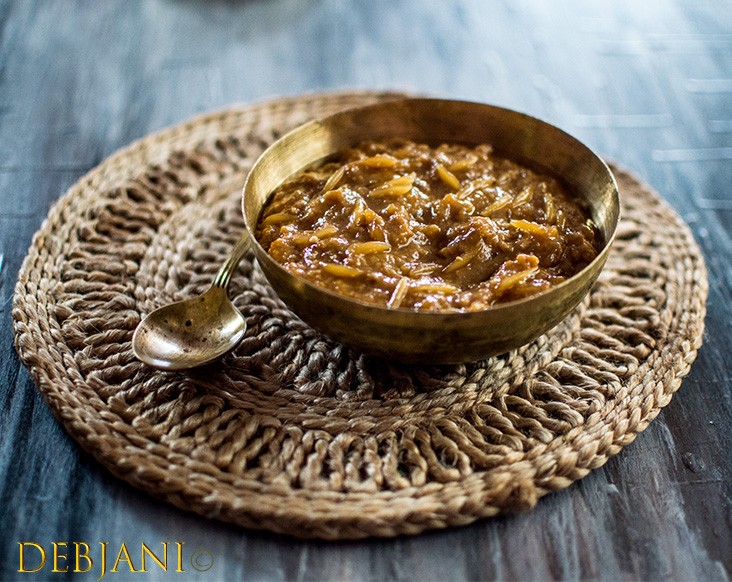
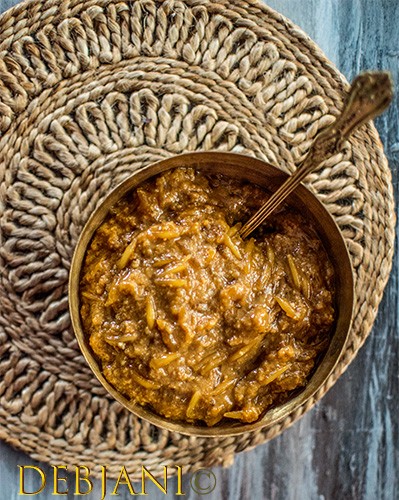
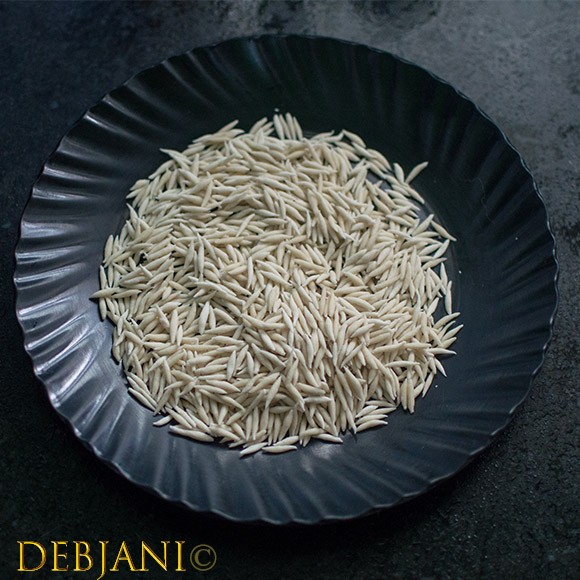



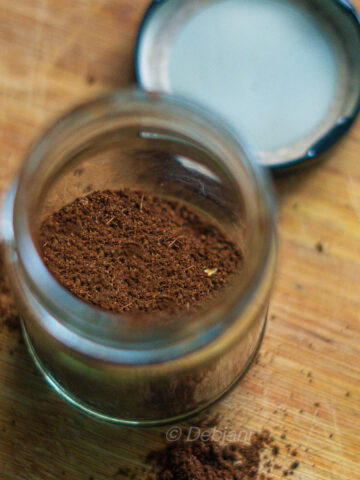
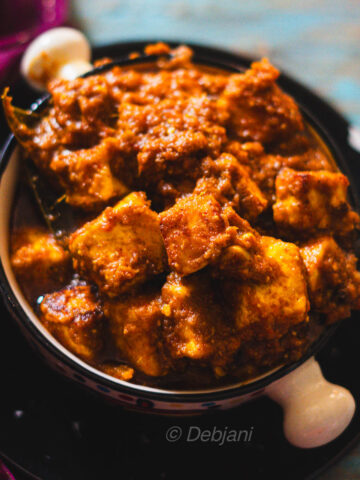
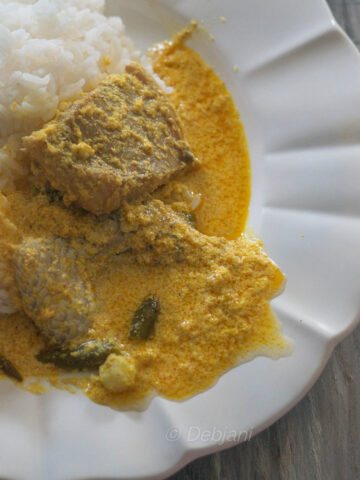
Leave a Reply